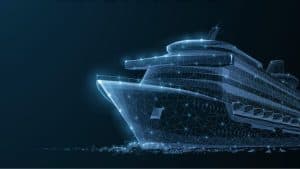
As the world continues to open for travel, cruise industry leaders are looking to leverage the next wave of travel technology to improve the passenger experience.
It was 2019 when Carnival Corp. first launched a ‘Star Trek communicator’-like device called “the OceanMedallion.” Since then, there’s been an Internet of Things (IoT) tidal wave of investments and advancements from cruise lines and operators. It’s transforming the way people cruise across the globe, and – in many ways – cruise tech is still emerging to provide a real-time picture of the ship’s most valuable cargo, its passengers.
![[Download Infographic Now] Vectorization Explainer: A New Form of Parallel Processing](https://no-cache.hubspot.com/cta/default/8019034/e171aa14-f37e-4a3b-a4c7-a0fa7538b5bc.png)
The potential applications for IoT on these technology-enhanced floating cities are limitless. From fuel optimization to pre-emptive maintenance, improved logistics to health and safety, advanced technology is playing a key role in operations. While cruise lines pursue IoT solutions at different levels, it is swiftly unleashing a new approach to customer experience on the open seas.
See also: How You Track 70,000 Ships in Real-Time
Understanding guest preferences with IoT insights
Now more than ever, cruise lines are using data and analytics to create a personalization engine that gives guests control over different touchpoints in their cruising experience. Based on passenger behavior, these engines can learn, record, and assist crews in responding to preferences from the moment of boarding. Brands can collect detailed data to better understand the customer journey, tailor-make offers, and drive relevant content.
Crew members welcome the efficiencies technology creates when it comes to entering a guest room for servicing, sending mass communications to all passengers, or accessing personal medical records during an emergency.
While guests enjoy the experience on their own terms, behind the scenes is an innovative digital system. To customize each aspect of a passenger’s itinerary, often, cruise lines use mobile, cloud, machine learning, and data analytics to create a layered technology infrastructure to segment passengers and recognize each guest as an individual.
Through insights, algorithms, and the help of artificial intelligence, guests’ preference profiles are constructed. Unspoken desires, such as automated temperature and lighting in cabins or TV recommendations, are documented and stored for future travels.
Placing guests at the center of digital design
Cruise lines are betting on digital technology to transform their business by creating better applications, implementing wearable technology, or stand-up microservices from legacy systems to improve operations. The entire customer journey has become digitalized, with cruise lines better able to predict what customers want before they even know they need it.
The potential utilizations for IoT on cruise ships are infinite:
- Mobile applications aid in exploring, planning, and booking activities at a customer’s fingertips.
- Onboard location services allow guests to order food and beverages from their mobile devices. While crew members are alerted to individual food allergies or sensitivities, they can also deliver directly to where the guest is located.
- Artificial intelligence, algorithms, and machine learning expedite embarkation with facial recognition and passenger counting.
- Wearables support with contact tracing and contactless activities like cabin entry, gateway management, and payment.
Exclusive, hyper-personalization requires a full stack of networking, software, application, and business insights to drive user experience. To deliver this, cruise lines must tackle the challenges of building technologies that are future-proof or augment legacy systems with new technology.
Outlook of invigorating B2C channels
Service is truly key as it has become increasingly clear a cruise line’s competitive advantage lies in the customer experience. The allure of creating a personalized program is appealing to leaders as benefits include improved customer satisfaction, revenue growth, brand loyalty, and the opportunity to create new products, services, or business models.
For many cruise lines, digital transformation means more than developing an application or updating technology. It’s about creating a digital-first mindset that focuses on providing a seamless experience in every interaction for guests.
![[Download Infographic Now] Vectorization Explainer: A New Form of Parallel Processing](https://no-cache.hubspot.com/cta/default/8019034/e171aa14-f37e-4a3b-a4c7-a0fa7538b5bc.png)




























